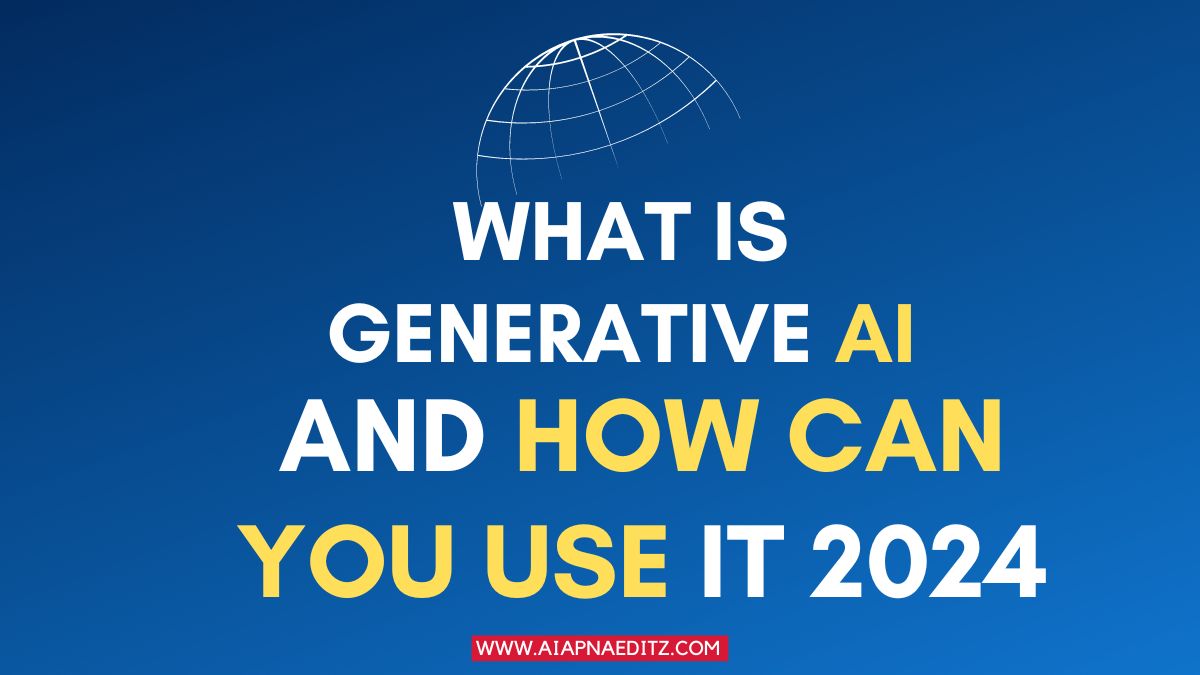What Is Generative AI and How Can You Use It 2024 Generative AI, a cutting-edge facet of artificial intelligence, harnesses the power of neural networks and vast datasets to create new, unique content across various mediums such as text, images, and videos. As we move into 2024, understanding how generative AI functions and exploring its applications can provide significant advantages in creativity, efficiency, and innovation.
What Is Generative AI and How Can You Use It 2024
Key Takeaways
- Generative AI enables the creation of new content by learning from existing data without directly copying it.
- It relies heavily on neural networks and machine learning models to identify patterns and generate outputs.
- Applications of generative AI span across creative arts, business, education, and more, enhancing productivity and creativity.
- Challenges such as data biases and the unpredictability of results need careful management to harness AI effectively.
- Understanding and leveraging generative AI can provide a competitive edge in various industries by boosting innovation and efficiency.
Unpacking Generative AI: What It Is and How It Works
Understanding the Basics
What Is Generative AI and How Can You Use It 2024 Generative AI is all about creating new, realistic artifacts from existing data. It learns from what’s already there and then goes on to produce novel content—think images, text, music, and more. This AI isn’t just copying; it’s using deep learning to genuinely innovate.
The Role of Neural Networks
Neural networks are the backbone of generative AI. These complex models mimic the human brain’s structure and functionality, enabling the AI to process and learn from vast amounts of data. The more data it has, the better it gets at generating high-quality, diverse outputs.
From Data to Content
Turning raw data into engaging content is no small feat. Generative AI systems start with a hefty dataset, apply neural network magic, and voila—new content is born. This process involves pattern recognition and rule creation, which are critical for the AI to operate autonomously and effectively.
Exploring the Real-World Applications of Generative AI
Creative Arts
What Is Generative AI and How Can You Use It 2024 Generative AI is making waves in the creative arts, transforming how artists create and share their work. It’s not just about replacing human creativity but enhancing it. Artists are using AI to explore new forms of expression, from digital paintings to interactive installations. This technology is opening up possibilities that were previously unimaginable, allowing artists to push the boundaries of traditional mediums.
Gaming Industry
In the gaming world, generative AI is a game-changer. It’s being used to create more immersive and dynamic gaming environments. Developers are leveraging AI to generate complex game worlds and realistic NPC behaviors, making each player’s experience unique. This not only enhances the gameplay but also significantly reduces the time and resources needed for game development.
Business and Marketing
What Is Generative AI and How Can You Use It 2024 Generative AI is revolutionizing the business and marketing sectors by automating content creation and data analysis. Companies are using AI to generate marketing copy, reports, and even personalized customer communications. This automation leads to more efficient workflows and targeted marketing strategies, ultimately boosting business productivity and engagement.
The Business Edge: Leveraging Generative AI for Competitive Advantage
Innovation and Automation
Generative AI is transforming how businesses innovate and automate processes. By automating routine tasks and generating new ideas, companies can focus on strategic growth and innovation. For example, AI can automate customer service interactions or optimize logistics operations, freeing up human resources for more complex challenges.
Personalization and Customization
Generative AI excels in delivering personalized experiences to customers, which can significantly enhance customer satisfaction and loyalty. By analyzing customer data, AI can tailor products, services, and interactions to individual preferences, driving higher engagement and sales.
Boosting Efficiency and Productivity
Generative AI tools are key in boosting organizational efficiency and productivity. They enable faster decision-making and problem-solving by processing large volumes of data quickly and accurately. This capability is crucial in industries where speed and accuracy are paramount, such as finance and healthcare.
By leveraging generative AI, businesses not only streamline operations but also create opportunities for innovation and growth.
The Creative Playground: Generative AI in Arts and Entertainment
Revolutionizing Art Creation
Generative AI is transforming the art world by enabling artists to create unique pieces using advanced algorithms. Artists can start with a basic concept and explore countless variations, enhancing creativity and innovation. This technology is not just about creating art from scratch but also about refining and reimagining existing works.
Transforming Music Production
In the music industry, generative AI is making waves by assisting artists in composing new songs and refining sound quality. It’s like having a virtual assistant that never tires, offering endless possibilities for melody and harmony. This technology is particularly useful for experimenting with different musical styles and generating innovative sound effects.
Innovating in Film and Video
Generative AI is also making a significant impact in the film and video industry. From creating realistic visual effects to editing sequences for dynamic storytelling, AI tools are essential for filmmakers looking to push the boundaries of what’s possible. Advanced video generation techniques allow for immersive animations and stunning effects, making the viewer’s experience more engaging and enjoyable.
Navigating the Challenges and Limitations of Generative AI
Addressing Data Biases
Generative AI systems are only as good as the data they’re trained on. Biases in training data can lead to skewed or unfair outcomes. It’s crucial to use diverse datasets and continually refine the AI models to mitigate these biases. Here are some steps to address data biases:
- Audit datasets for diversity and representation.
- Implement regular checks and balances during AI training.
- Engage diverse teams in the development and review process.
Managing Unpredictable Results
The nature of generative AI can sometimes produce unexpected or erratic outputs. This unpredictability can be a hurdle, especially in sectors where precision is critical. To manage this, developers can:
- Set clear parameters and constraints for AI operations.
- Use robust testing and validation frameworks.
- Continuously train AI with updated and varied data sources.
Overcoming Creativity Constraints
While generative AI can produce a wide range of content, it’s not inherently creative. It replicates patterns from existing data, which can limit its ability to generate truly novel ideas. To push the boundaries of AI creativity, consider:
- Combining AI with human creativity to enhance output.
- Developing AI systems that can learn from feedback and adapt.
- Encouraging interdisciplinary approaches to AI development.
Note: As we harness the power of generative AI, it’s essential to address these challenges head-on to fully realize its potential.
The Future of Education and Training with Generative AI
Enhancing Learning Experiences
Generative AI is revolutionizing the way educational content is delivered and experienced. By creating interactive and adaptive learning materials, it tailors the educational journey to the needs of each student. This personalized approach not only makes learning more engaging but also more effective.
Customizing Educational Content
With the ability to analyze and understand individual learning styles and preferences, Generative AI can create customized educational programs. This ensures that every learner receives the most relevant and impactful education possible, making the learning process both enjoyable and efficient.
Facilitating Remote Learning
The global shift towards remote learning has highlighted the need for flexible and accessible educational tools. Generative AI steps in by providing robust platforms that support a variety of learning modalities, from virtual classrooms to AI-driven tutoring systems. This technology is pivotal in ensuring that education remains uninterrupted, no matter where the students are.
Generative AI in Research and Development: Pushing Boundaries
Accelerating Scientific Discoveries
Generative AI is revolutionizing the pace at which scientific discoveries are made. By automating the analysis of vast datasets, AI models can identify patterns and insights that would take humans years to uncover. This capability is particularly transformative in fields like genomics, climate science, and materials engineering.
Optimizing Product Development
In the realm of product development, generative AI is a game-changer. It enables companies to simulate and test thousands of design variations quickly, finding the optimal solution without the traditional time and material costs. This not only speeds up the development process but also enhances the quality of the final products.
Enhancing Research Efficiency
Generative AI significantly boosts the efficiency of research processes. It automates routine tasks, allowing researchers to focus on more complex and creative aspects of their work. This shift not only accelerates research timelines but also reduces the likelihood of human error, leading to more reliable results.
Wrapping It Up
As we’ve explored throughout this article, generative AI is not just a technological marvel; it’s a versatile tool that’s reshaping how we create and interact with content across various fields. From automating mundane tasks to enhancing creative processes, the possibilities are endless. As we move into 2024, embracing generative AI could be a game-changer in both personal and professional realms. So, why not dive in and see how it can revolutionize your world? Remember, the future is not just about observing; it’s about participating and innovating!
Frequently Asked Questions
What is Generative AI?
Generative AI refers to machine learning models that create new content such as text, images, video, audio, or software code. It utilizes neural networks and training data to produce unique and realistic artifacts that reflect the characteristics of the training data.
How does Generative AI work?
Generative AI operates through neural networks, deep learning algorithms, and machine learning models. It learns from vast amounts of training data to recognize patterns and generate outcomes, producing a variety of content like images, text, videos, and more.
What are the most common use cases of Generative AI?
Generative AI is widely used in creative arts, the gaming industry, business and marketing, research and development, and education and training, where it helps in creating innovative content and personalized experiences.
What are the advantages of using Generative AI?
Generative AI offers innovation and automation, personalization and customization, and accessibility and inclusivity. It enhances productivity and creativity across various fields by automating routine tasks and generating new content.
What are the limitations of using Generative AI?
The main limitations include dealing with data biases and unpredictable results. Generative AI may also face challenges in matching the level of human creativity due to the inherent constraints of its training data.
How can Generative AI impact our work lives in 2024?
In 2024, Generative AI is set to transform work and communication methods significantly. It will automate mundane tasks, enhance creative processes, and improve decision-making, thereby reshaping industries and boosting productivity.






